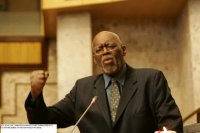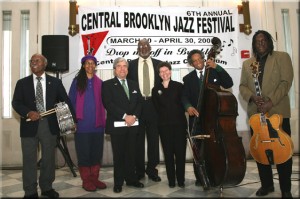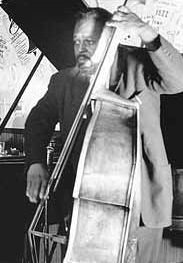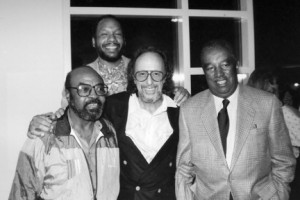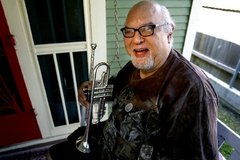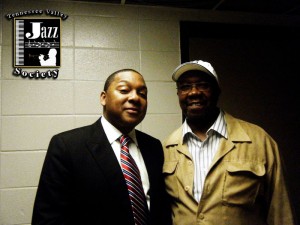The Independent Ear series of conversations with African American jazz entrepreneurs — classic & contemporary — continues, this time in Brooklyn, NY…
Remembering The East with Jitu Weusi
PART ONE: A jazz fan in development…
One of the revelations of the Lost Jazz Shrines of Brooklyn research project for the Weeksville Heritage Center (see elsewhere on Open Sky Jazz) has been the extensive interviews with key Brooklyn figures. The magnitude of Brooklyn’s mid-20th century jazz history was first brought home in writing African Rhythms, the autobiography of NEA Jazz Master Randy Weston (composed by Randy Weston, arranged by Willard Jenkins; available on Duke University Press in October ’10). Great stories and the light of revealing history has continued to be shed through this ongoing series of Weeksville interviews.
One such saga is that of The East, a pioneering African American cultural institution which rose up in Central Brooklyn in 1969 and was the jazz venue in the borough for several years, among its many extraordinary deeds. My knowledge of The East had been limited to the recordings Pharoah Sanders Live at The East (which point of fact wasn’t actually recorded at The East, but was a studio date in the spirit of Pharoah at The East), and percussionist Mtume’s Alkebu Lan for Strata East, which was indeed recorded during one of the always-spirited jazz nights at The East. There were also enriching and delightful personal experiences at the annual African Street Festival (now known as the International African Arts Festival), which was birthed by The East, but I never had the pleasure of visiting The East’s storied jazz sessions.
The East, which was so much more than a jazz performance venue, is a classic example of the kind of African American self-determination that flowered in the late 1960s-early 1970s as bright flowers of the civil rights struggle. To gain insights into the origins and development of The East there was no better place to start than with one of the historic figures of post-60s public education, politics and culture in Brooklyn, Jitu Weusi. We interviewed Jitu, a tall, gray-haired, unassuming eminence on a warm, late-spring morning at his current office at The Central Brooklyn Jazz Consortium on Fulton Street, where he serves as chairperson. This first of two parts will detail Jitu’s early history with jazz; part two will detail the development of The East, just part of our wide-ranging interview which will eventually be available as part of the Weeksville archives. Like so many of us, Jitu’s interest in jazz grew through the oral tradition.
Jitu Weusi (center in tie & glasses) celebrating an event at the 6th annual Central Brooklyn Jazz Festival with among others Brooklyn Borough President Marty Markowitz (to Jitu’s left)
Willard Jenkins: What are your earliest memories of jazz music?
Jitu Weusi: I was about 12 years old and my cousin Charles Morris had a newstand. I was the first born of my generation and he called my mother and said ‘I want Leslie” — that was my name until I changed it — ‘to work at the newstand on Saturdays.’ So that started a new era in my life, going down to the newstand on Saturdays.
Every Saturday morning I would get up about 7am and be out of the house by 8; by 8:30 I was at the newstand and I would be there until about 6:30-7pm. I had a number of tasks to do: in those days you prepared your Sunday papers with the various sections on Saturdays; so I would put together the Daily News, the Times, and the Tribune. The main news section usually came about 8pm on Saturday night and you just inserted them in there and the papers were ready to be sold. The newstand was located right on the corner of Fulton and Franklin. Fulton and Franklin at that time was a very, very hot corner. It was hot for two reasons — Ebbets Field [legendary home of the Brooklyn Dodgers] and Coney Island; you got the train to go to Ebbets Field and Coney Island at Fulton & Franklin. So people would come out of that subway and make it to the elevated line upstairs and get those trains. So from March-October there was a lot of traffic. That was a very trafficked area anyway; blacks had just started to move in that area.
Across from the newsstand, on the southeast corner was a record store called Sam the Record Man. Now Sam the Record Man, like all good record stores, had this loud outdoor [sound] system and they used to play records all day long. Many of these records I had never been exposed to before. It was my first time being exposed to people like Ruth Brown, Fats Domino… a lot of the early progenitors of rhythm & blues; but also he would play jazz: King Pleasure, Charlie Parker, Billie Holiday, Ella Fitzgerald… he played different vocalists as well as instrumentalists. After awhile I began to know who was who and what their tunes were. My cousin and his brother — they were the two male figures that operated the newsstand — my cousin Charles Morris was the oldest,, he was a disabled vet and it was under his auspices, his disability, that he was able to get the newsstand. His brother, Leroy Morris, worked with him. Leroy’s nickname was Lefty, and he was very athletic, and he knew all the jazz guys; he knew [Brooklyn drummer] Willie Jones, Max [Roach]…
WJ: This is Lefty Morris the basketball player? He talked Randy Weston into going up to the Berkshires to “escape” Brooklyn.
JW: That’s right, he knew all the jazz guys… He knew [drummer-dancer] Scoby Stroman, Willie Jones, Max Roach… these guys used to come by the newsstand all the time, even if he wasn’t there. I was “youngblood”… [it was] ‘hey youngblood, what’s happening man…’ Like I said, I was 12-13 years old. They were glad to see that I was halfway alive, halfway awake… I’d always been into reading the newspapers and I knew who was who, like Mao Tse Tung, Stalin… If they’d given me a current events quiz I could whiz through it because I knew people, I knew figures. They used to always tease Lefty, ‘yeah man, I came by and youngblood was there and we laid out there and talked about world politics for awhile…’ So that’s when I had my sort of baptism to the music and to the community.
A third thing I remember during that period was, my cousins Lefty and Charles’ sisters, they were like in their early 20s. At my 13th birthday they took me to the New York Paramount to see a stage show and it was an all-jazz stage show. I remember it was Count Basie and Joe Williams, Sarah Vaughan and Teddy Wilson, George Shearing… it was about 3 or 4 acts. I remember that show vividly; it was the first time I’d seen a big band [Basie], they swung pretty heavily. I remember Joe Williams and his blues singing… I enjoyed myself and learned a lot about the music.
During my teens I really didn’t get into too much related to jazz. I guess I was like everybody else, I was into the R&B craze, the stage shows, Frankie Lymon & the Teenagers and all that kind of stuff. At about 17 I was working in the camps upstate and I started listening to jazz much more often; I started buying a few more records.
Who were you listening to then and whose records were you buying?
JW: I was buying Art Blakey & the Jazz Messengers; I remember “Blues March,” this was the Messengers where he had Bobby Timmons, Lee Morgan, Wayne Shorter, Jymmie Merrritt… And I was listening to Horace Silver, “Senor Blues” and his different compositions. Those were the opening, teenaged years of listening to records.
Then I remember that I had a little girlfriend when I was about 19; she used to live in the Dunbar Houses at 150th Street and 7th Avenue [Harlem], and her mother was very, very strict; like 12 at night you had to go, ‘she gotta go to church in the morning, she gotta do this, gotta do that… 12:00 you gotta hit the road young man.’ I found this place right at 155th and 7th Avenue called Brankers, a music bar.
What was happening at Brankers was really prostitution, but I didn’t know all that. I couldn’t see all that. Brankers was like a meeting spot where all these guys would come and hook up with their lady friends and go upstairs. But in between, they had live music downstairs; they had Kenny Burrell, Grant Green, Shirley Scott… these trios; it usually was an organ player, a guitar player, and a drummer or an organ player, a saxophone player and a drummer. I’d go to Brankers at 12:30 and I could sit there until 2am listening to music. I could buy a beer and nobody would bother you; get out there, catch the train and go home. That became another thing that introduced me to the music.
In the summertime I used to go up to the Catskills area to work in these camps. When I was about 20 I went to this camp called Wingdale on the lake. At some point during that summer this guy named Bill Tatum became the entertainment director of the camp and we became friends. After the summer he told me to keep in touch, he was going to get me some more work. When I called him he told me he was working at Wells’ upstairs room on 113th & 7th Avenue, home of chicken & waffles. I had to go down and get my cabaret card and he got me a job working at Wells. Wells was good to me as a work spot, and I also stayed close to the music. They played a lot of Dakota Staton, Gloria Lynne, and all that kinda stuff. But every now and then they’d have a trio, so I heard more live music too. Of course now I’m getting older and I know the different radio stations, I’m listening to Symphony Sid. By that time, I was maybe 20-21, I had begun to dabble in Miles Davis, Coltrane, a little Cannonball Adderley, etc. I got so absorbed I remember on my 20th birthday I took this girl to the Five Spot to see the opening of Ornette Coleman. Now my musical tastes are broadened and I’m into a wider range of artists.
One particular night we went down to the Village Gate to see somebody. While I was there I heard this woman manager say ‘I need some waiters…’ I made my way back to her and said I used to work in Wells upstairs room in Harlem. She asked if I had a cabaret card, I said yeah, she said ‘you’re hired.’ The next day I started working at the Village Gate and that was golden! I saw everybody: Nina Simone, Thelonious Monk… I not only saw everbody, but I got to meet everybody, guys I had listened to, like Art Blakey… I found out that some of them lived in Bedford-Stuyvesant, like [bass & oud player] Ahmed Abdul-Malik. He would play with Herbie Mann and after the set he would say to me ‘youngblood, you goin’ to Brooklyn, come on, I’ll give you a ride’ and he would take me home. That was a period in which I really became a solid member of the jazz fraternity.
Bassist-oud player Ahmed-Abdul Malik played with Randy Weston, Thelonious Monk and Herbie Mann among many others.
What was happening jazz-wise in Brooklyn at that time?
Brooklyn had a lot of things going on club-wise. When I worked at the newsstand the Putnam Central Club was hot. But I was 13; I used to hear Lefty and them talk about the PCC, Tony’s on Grand Avenue… I remember one time I tried to go to The Continental [Brooklyn jazz club], and I looked in there and who did I see but my cousin, a traffic policeman. Here I am peeping in the door and he’s sitting in the back there, so I got the message: ‘don’t mess around!’ Yes, there was a very active jazz scene in Brooklyn during that period.
When you became of age to frequent the clubs, what was the Brooklyn jazz scene like then?
When I was 21, about 1960, the scene was not bad, there were still some clubs that we could go to, key among them was The Blue Coronet. I was a frequent visitor there, esepcially when I started teaching — which was about ’62. We had a little crew of men and women who worked in the schools and we would call each other [and ask] ‘who’s at The Coronet tonight? Let’s go down there.’ The Blue Coronet was the top [Brooklyn] club at that time. La Marchal had sort of come and gone. It wasn’t a prominent club even though Freddie [Hubbard] and [Lee Morgan] made a record [Night of The Cookers] there and gve it some glory.
The Continental had come and gone too, their best years were in the 50s. Tony’s was there, but the PCC had closed and changed ownership. Rusty’s Turbo Village had regular music. You had a lot of bars [in Brooklyn] and every now and then they’d have somebody there: Berry Brothers, Tip Top, Monaco…
So as you evolved as a fan of the music, how did you come to escalate your involvement to the point where you became an activist and even a cultural entrepreneur?
I graduated from Long Island University in June 1962 and I became a teacher in September 1962. I became interested in the music not only from an enjoyment perspective, now I became interested in it from an educational perspective. I did experimental things like play different music in my classes and kids would tell me they had never heard any music like that. I played Olatunji’s Drums of Passion in my class and it was a heavy turn-on; ‘wow, what’s that, where did that come from, who’s that?’
So I saw that the music had a lot of educational value, turning on the youngsters to various sounds, various performers. Oscar Brown Jr. was another person I used in my classes, different sides that he made: “Dat ‘Dere,” “Signifyin’ Monkey,” “Bid ‘Em In”… So I now thought of ways to use the music as a motivator in the education of youngsters, especially in the area of social studies. Now the music became a valuable kind of tool, more than just my listening; now I listened for different purposes and different meanings.
My own repertoire continued to broaden, my collection continued to broaden… I remember at a certain time I was exposed to the music from “Black Orpheus,” this brought me into contact with the African population of Brazil and their story. I remember I took a class to see “Black Orpheus” and [the students’] whole reaction to seeing these black people speaking [Portuguese], and having a different kind of culture… It sparked a whole lot of questions when we got back to school: ‘…How’d they get there, what language were they speaking…?’
[For me] The music now became [sociological] and worldly, universal… not just located in the United States, [but] as a universal commodity, all over the place; I began traveling different places. I remember my first experience, around 1966, going to Newport to the jazz festival. I could have never stayed in Newport, because the money to stay in Newport was way up there. So we ended up staying in a place called Fall River, Massachusetts. I didn’t know it at the time, but places like Fall River and New Bedford [MA] were places that basically had an African-based population from runaway slaves that intermarried with a lot of the Portuguese that lived in those areas. And there was a very strong kind of cross-fertilization between those communities and the African community, so when I came up there to stay for Newport [Jazz Festival] I found a lot of people that were very supportive and very glad to have us stay there. All of that helped to broaden me and broaden my understanding of the music and the people, and the backgrounds and how it fit in.
I began to see this music in a more historical context. My mother used to listen to people like Louis Jordan, she told me about Chick Webb and different people like that. Now, by the late 60s all of this begins to tie together, like a historical pattern that’s beginning to develop [for me]. Now I’m beginning to see this [music] in a historical, sociological, philosophical context, and I’m beginning to understand that [jazz] is a revolutionary music, it’s a music of an oppressed people that has sort of guided a movement over the years.
By the mid-60s I became active in political activities: school struggles, around the struggles to decolonize public education. We used phrases like “community control,” but it basically dealt with the whole question of colonial educational pespectives. I belonged to an organization then called the African American Teacher’s Association and we put pressure on the board of education to open up the whole school [curriculum] and become more accepting of different cultural perspectives. When I came into teaching they gave us some books and some curriculum outlines to follow, and most of that was white. Like they used to say in the old days, the only two [black folks] they mentioned were George Washington Carver and Booker T. Washington… that was the full extent of our history.
Now I’m beginning to deal with Crispus Attucks, Phyliss Wheatley, the Louisiana Purchase of 1803, Toussaint L’Overture and the Haitian revolution… I’m dealing with a whole broad kind of struggle of Africans for their freedom and independence. In the midst of all this is the music. Now my whole thinking begins to take on new dimensions.
I was part of the group that used to listen to [jazz radio hosts] Ed Williams and Del Shields on WRVR; that was our religion; we had to get home in time to listen to them because of all the information that was dispensed on those two shows. Our music and our politics now became more toward the same track.
Next: The birth of The East, and how jazz was an integral part of that historic font of black culture and education.
For more information on the Weeksville Heritage Center visit www.weeksvillesociety.org; to learn more about the Lost Jazz Shrines of Brooklyn project email research@weeksvillesociety.org.

